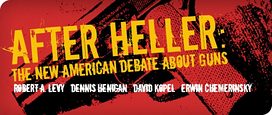Dennis Henigan’s theory that Heller paves the way for new gun controls, by eliminating fears of the slippery slope, might be possible in the long run, but is probably not correct in the short run.
First of all, Heller was a 5-4 decision. Even if a Supreme Court a few years from now did not formally over-rule Heller, the Court could constrict Heller so tightly that it could become the last case which even meaningfully applied the Second Amendment. A future Court could also greatly reduce Heller’s scope by refusing to make it enforceable against state and local governments. There is every reason to believe that an Obama Court, at the urging of an Obama DOJ, would do so. In 1996 Obama endorsed handgun prohibition; in 2007, his campaign said that Obama supported the D.C. handgun ban. Obama has proposed outlawing all self-loading guns, banning all gun stores within five miles of a school or park (i.e., almost everywhere except roadless wilderness), and national legislation to override the handgun licensing laws of the 48 states which allow citizens to carry concealed handguns for lawful protection. Post-Heller, he claims to be against the D.C. handgun ban, and says he has always supported the Second Amendment individual right. Assuming that his claim about the Second Amendment is sincere, his version of the Second Amendment does not stand in the way of banning most guns.
Second, nothing in Heller stops the United Nations’ current global campaign against firearms ownership. The international gun prohibition lobby IANSA (International Action Network on Small Arms) is the “the organization officially designated by the UN Department of Disarmament Affairs (DDA) to coordinate civil society involvement to the UN small arms process.” The UN’s official representative of civil society favors handgun prohibition, prohibition of any rifle that can shoot 100 meters (e.g., almost all of them), prohibiting gun ownership for self-defense, and drastic reductions in levels of gun ownership. IANSA and the UN are currently working on an Arms Trade Treaty to eliminate gun sales to countries which violate human rights — which by the UN and IANSA definition means the United States; the UN and IANSA have already declared that laws like those in the U.S., which allow a woman to shoot a rapist, are a violation of the human rights of the rapist. The Brady Campaign, incidentally, is a member organization of IANSA.
We know that there are often four Justices — and sometimes five — who will use unratified treaties (like CEDAW, the Convention on the Elimination of all forms of Discrimination Against Women), or treaties which are not even applicable to the United States (like the African Convention on the Rights of the Child), as guidance in interpreting the U.S. Constitution. After two terms of President Obama, there could be several more such Justices.
As Henigan points out, Douglas Kmiec, who would likely be one of President Obama’s top Supreme Court advisors, has bitterly criticized Justice Scalia’s opinion in Heller. Kmiec chastises the Catholic Scalia for disregarding a 1978 statement [see p. 26 of the linked article] by the United States Conference of Catholic Bishops in favor of a handgun ban.
Did the June decision in Heller reduce the immediate risk of the slippery slope? Yes. Will that protection survive an Obama presidency in which the U.S. delegation at the United Nations (as in the Clinton years) enthusiastically supports the global prohibition campaign, and in which a President Obama, advised by Douglas Kmiec, appoints Justices who believe in the Obama/Kmiec vision of the Second Amendment — and in using international “norms” to constrict American rights? Constitutional rights advocates who think that the slippery slope problem has been resolved once and for all would be naïve.

